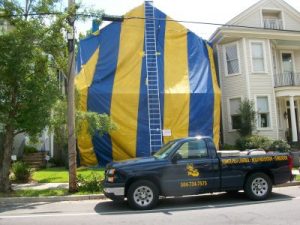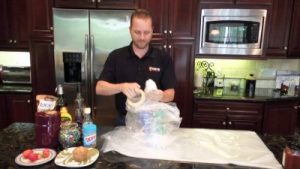
If you live in south-east states in the US, the fear of termites is something that follows you for a lifetime.
You possibly know that the repairs and prevention of damage made by termites every year costs billions of dollars to house owners and state each year.
The fight with the local nests of drywood termites might take long time and in the end you might discover that there was one you missed and you can start all over again.
One of the good methods for fighting all of the nests at once is structural tenting. Let me tell you everything there is to know about it.
Hide content
- Which termites can be exterminated by fumigation?
- When you should use the tenting method?
- Can I make the tenting myself?
- What is the gas used in fumigation, is it dangerous?
- How to prepare for the fumigation?
- How the fumigation is done?
- Useful articles
- Helpful video
- What to do after the fumigation?
Which termites can be exterminated by fumigation?
First of all – not every termite species will be successfully exterminated by fumigation.In this section we will be speaking about termite fumigation (tenting): health risks that could happen and measures that should be done in order to prevent any danger. To begin with, there are two main types of termites that are dangerous to houses in US:
- Subterranean.
- Drywood.
To form colony subterranean termites need two things: the soil and good source of water.
The main nest will be located underground and the termite workers (the ones that are the main consumers of cellulose) are normally only visiting the building through their mud tubes.
The colonies of the subterranean termites are usually large, up to millions of individuals in case of Formosan termite infestation and are not residing inside the house.
So, tenting will not help you in this case, as it kills only the insects that are thriving inside the wooden structure and the subterranean termite can always quickly reenter if the nest stays untouched.
Drywood termites, according to their name need nothing else than dry wood to form a colony. The nest can have only couple of hundreds individuals and be established entirely in just one piece of furniture.
So, in case of drywood termites the fumigation of the entire structure will guarantee the extermination of all the possible nests in the household.
So, before choosing the structural tenting as a fighting method, you have to know for sure that the pests that endangered your property are indeed drywood termites.
To identify them, the best way is to lay a hand on few flying termites or even just their shed wings.
If you noticed the swarm nearby or right inside your house, check for the alive or dead termites on the window sills, door sills and in the areas where the humidity can attract the subterranean alates, (winged reproductive termites) such as under the sink or in the cellar.The collected clues you better bring to the pest control specialists in your region, because the identification requires some special knowledge and magnifying equipment.
If you don’t have the winged individuals, but you sure that the house is infested, check for the frass. That is the compressed excrements of the drywood termites that are pushed out of the nest by them, while workers are chewing their way through the wood.
The pile of frass looks like sawdust, so once you found it – look closely, better with magnifying glass. The real sawdust will be all similar color and the excrements will vary on color and be shaped in small clusters.
Learn more about drywood termites: signs of their activity; best methods of treatment: spot treatment and DIY methods; how to get rid of them in furniture?
When you should use the tenting method?
Sometimes the colony of the drywood termites is small and localized in easily achievable place, like a single plank of wood that can be simply removed, burned and then replaced.
In such a case there’s no need for the costly and long process of fumigation. Let your pest specialist examine the house.
If he finds one-two local nests, surely he will use other methods and mostly focus on prevention of the further infestation.
But sometimes the infested wood is hard to reach or cannot be simply removed. Also the specialist might suspect numerous nests in the household.
The fight with the nests one by one doesn’t make much sense then. In this case you will be offered a structural fumigation as a guarantee of getting rid of all the existing nests.Can I make the tenting myself?
The simple answer is no. The gas that is used in structural tenting requires special training and certification. Plus, the orientation in the specific brand usage by the production company is needed as well.
So the fumigation is 100% not a DIY method. If you decide that you need it – find a certified specialist from the reputable pest control operator to perform it. Now, let’s move to termite tenting (fumigation) dangers that could happen with human.
What is the gas used in fumigation, is it dangerous?
The general name for the termite gas is sulfuryl fluoride. The use of the other fumigating gas – methyl bromide was banned in the US because of its negative impact on the ozone layer.
For now exists three brands of sulfuryl fluoride:
- Vikane (by AgroSciences).
- Zythor (by Ensytex II).
- ProFume (by AgroSciences).
The gas can perfectly penetrating the walls and any porous wooden structure.
The termites under its influence are dying in few days.
So do not be alarmed if after tenting you still see some termites in the houses – they will die very soon.
One important thing about tenting for termites – health risk, in high concentration the gas can be dangerous for humans and pets and even lead to death.
But in small doses it has practically no impact on health.
The sulfuryl fluoride is colorless and odorless and to avoid inhaling it without noticing in case of leakage the specialists often add some tear gas to the mixture, then the presence could be noticed immediately.Once the tent is removed, the gas aerates easily and normally in 6 hours completely disappears, leaving no residual. The good side of this quality is that you don’t need to wash or clean specially anything when you came back after fumigation, that includes your clothes and dishes.
It also doesn’t damage the electronic devices, so they don’t have to be removed from the house for tenting.
The only drawback of no residual is that fumigation on its own does not protect the household from future infestation and for this has to be combined with further preventive measures.
Learn more about subterranean termites: signs of their activity; best methods of treatment and DIY methods. Eastern subterranean termites and their tunnels and tubes with photo.
How to prepare for the fumigation?
There’s not too much to do. Consider that you will need to leave the house for around 72 hours, and prepare your bag accordingly.
Important! The time needed for the fumigation depends on the outside weather conditions and can vary.The other things to do:
- Don’t leave any pets inside, the concentration of the gas inside the house will be dangerous for their health.
- Take outdoors the home plants.
- Remove all the plastic covers from the furniture and especially children matrasses. It can later seal the gas inside and not allow it to aerate completely.
- Leave inside only the food that is still in untouched sealed package or double seal the open ones in plastic.
- Water the soil between the house and shrubs for preventing the escape of the gas from under the tent.
- Make sure you have the gas supply cut off for the days of tenting.
Here is a video that details what you need to do to get ready for the fumigation:
How the fumigation is done?
The idea of the treatment is to cover the whole structure by a huge tent and release the gas inside. As simple as it sounds it still requires a well-qualified specialist.Being odorless and invisible, the gas can be traced only with special equipments:
- Fumiscope.
- Leak detectors.
- Clearance device.
During the whole treatment, the specialist will be using the fumiscope for keeping the concentration of the gas on the good level.
To ensure the complete pests extermination, normally it takes a bit more than 3000 parts per million.
To make sure there’s no leak of gas the leak detectors are used. And finally to recognize the safe moment for the owners return to their home, the operator need the clearance device that can detect the concentration as small as 1 part per million that is considered absolutely safe for humans. To sum up, the answer on the question: “Is termite fumigation safe?” will be: “Yes, but you should followe somr termite fumigation safety measures.”.
Useful articles
If you interested in more information of termites we recommend you to read the following articles:
- All types of termites. Are they harmful to humans? Can they bite you? And what is the difference between drywood and subterranean ones?
- What does swarmers of different species look like: drywood, subterranean, formosan?
- Signs of infestation outside and in the house: in walls or furniture.
- What does termite holes look like? What is droppings and is it toxic to humans? Do termites make noises?
- Posible termite damage, how does it look like? Examples of damage in walls and wood floors.
- All about flying termites: how do they look like, swarming season and what to do if there are swarmers in your house?
- How do they do nests and mounds? How to find it in your garden or inside the house?
- Termite life cycle – from egg to larvae. And social hierarchy: workers, soldiers, queen.
Helpful video
Learn more about how to identify the signs of termite infestations and how to eliminate them by tenting:
https://www.youtube.com/watch?v=gjqG-oWyEE0
What to do after the fumigation?
After structural tenting, the household should be absolutely clean from all drywood termites’ nests.
But don’t forget that the sulfuryl fluoride doesn’t leave any remaining protection for the wood.
So, now it’s a perfect moment to use the special wood treatment methods and other preventive measures to avoid the termites reentering your home in the future.
All about cleaning after the tenting.
Safe and effective, fumigation is a complicated procedure that has to be performed by licensed professionals.
Don’t make a mistake of doing it annually as a prevention measure, but use it only when other methods will not be radical enough.



